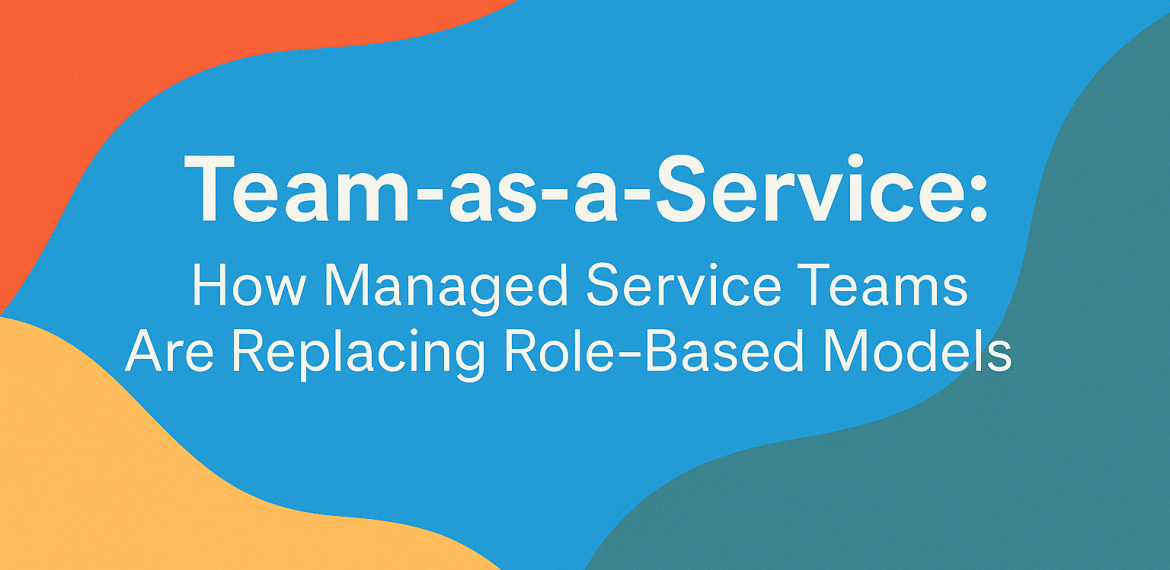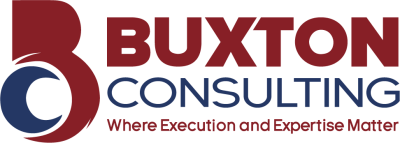
Team-as-a-Service: How Managed Service Teams Are Replacing Role-Based Models
Team-as-a-Service: How Managed Service Teams Are Replacing Role-Based Models
The Shift from Role-Based Hiring to Outcomes-Based Teams
For decades, businesses have followed the familiar path of hiring individual roles to fulfill specific job functions. Job descriptions were meticulously crafted, positions posted, and human resources teams scrambled to fill those roles with the best talent. But as digital transformation accelerates, customer expectations evolve, and projects become more complex, the cracks in this model are showing.
Hiring individuals for specific roles often leads to fragmented ownership, siloed communication, inconsistent quality, and misalignment between business goals and deliverables. Moreover, maintaining full-time staff for specialized skills that are only occasionally needed leads to wasted resources.
Enter Team-as-a-Service (TaaS) – a dynamic, scalable, and highly efficient alternative.
What is Team-as-a-Service (TaaS)?
TaaS is a managed service delivery model that provides complete, outcome-oriented teams tailored to the client’s needs. These teams are composed of cross-functional experts who are onboarded quickly and managed externally, often by a Managed Services Provider (MSP). Unlike traditional role-based staffing, TaaS is about capabilities, not titles.
These teams may include a mix of developers, business analysts, data scientists, testers, project managers, and other specialists – all focused on delivering a specific outcome, not just filling a seat.
Why TaaS is Gaining Momentum
Speed and Agility
Organizations need to move fast, but internal hiring processes are slow and cumbersome. TaaS teams can be deployed in weeks, not months, helping companies accelerate delivery and innovation without sacrificing quality.
Outcome-Oriented Delivery
Traditional staffing models focus on output (e.g., hours worked or tasks completed), whereas TaaS focuses on outcomes (e.g., features delivered, performance improved, customer satisfaction). The difference is profound – businesses get real value instead of just manpower.
Reduced Overhead
Hiring full-time staff involves recruiting costs, training, benefits, onboarding time, and HR management. TaaS eliminates much of this overhead by providing ready-to-go teams, already trained and experienced in similar engagements.
Access to Specialized Skills
Need an AWS architect, a cybersecurity expert, or a DevOps engineer for just 3 months? TaaS makes it possible to bring these skills in when needed and release them when they are no longer required.
Built-In Management and Governance
TaaS teams come with leadership and operational maturity. The MSP manages the team’s performance, governance, escalation, and reporting. This removes a massive burden from the client’s internal management teams.
How TaaS Differs from Traditional Role-Based Staffing
| Feature | Role-Based Model | Team-as-a-Service |
|---|---|---|
| Focus | Individuals and tasks | Team and outcomes |
| Hiring Time | Weeks to months | Days to weeks |
| Onboarding | Requires internal training | Pre-aligned, pre-trained |
| Management | Managed by client | Managed by provider |
| Scalability | Rigid and slow | Agile and flexible |
| Risk | High (turnover, misfit, gaps) | Shared by the provider |
Use Cases Where TaaS Outperforms Role-Based Models
Product Development
Launching a new software product? A TaaS setup can handle everything from backlog grooming to UX design, architecture, coding, QA, and deployment – all under one coordinated team with a shared goal.
Data Analytics Projects
Rather than hiring a data engineer, data scientist, and visualization expert separately, organizations can deploy a data analytics TaaS team that builds pipelines, models, and dashboards in a tightly integrated flow.
ERP Implementations and Migrations
Oracle, SAP, Salesforce – these platforms require multiple specialized roles. TaaS ensures alignment across functional, technical, and testing streams, avoiding handoffs and miscommunication.
Application Modernization
Modernizing legacy systems requires architecture redesign, microservices engineering, cloud migration, and user interface upgrades. A TaaS team can bring all these together with end-to-end accountability.
AI and Machine Learning Initiatives
Instead of hiring an ML engineer, MLOps specialist, and data wrangler one by one, companies can get a cohesive team that delivers ML models to production – and iterates on them based on real-world feedback.
How Organizations Can Transition to TaaS
Step 1: Define the Business Outcome
Start by identifying the objective – not the roles. What needs to be achieved? Is it a product launch, a legacy overhaul, a reporting upgrade, or a compliance project?
Step 2: Engage a TaaS Provider
Look for partners who can provide end-to-end teams, not just bodies. Evaluate their ability to scale, adapt, and manage delivery. Review case studies and client references.
Step 3: Integrate Governance
Establish clear governance mechanisms – reporting cadence, SLAs, escalation paths, and KPIs. Let the provider manage the team but retain visibility and control over progress and performance.
Step 4: Start Small, Scale Fast
Pilot with a small TaaS team for a contained project. Measure results, iterate, and then expand. Many organizations start with a single team and eventually build an ecosystem of TaaS engagements across departments.
Step 5: Align Internally
Ensure internal teams understand that TaaS is not a threat but a force multiplier. Encourage collaboration and knowledge transfer between TaaS teams and in-house staff.
Common Myths About TaaS
Myth 1: TaaS is Just Fancy Staffing
TaaS is outcome-driven. Unlike staffing, where individuals are billed hourly and managed by the client, TaaS teams are managed by the provider with a commitment to results.
Myth 2: TaaS Reduces Internal Innovation
TaaS frees up internal teams from grunt work, enabling them to focus on innovation and strategic priorities.
Myth 3: TaaS Teams Lack Domain Knowledge
Quality TaaS providers ensure domain alignment. Teams are trained in the client’s industry, processes, and business context – often more thoroughly than internal hires.
Myth 4: TaaS is Only for Tech Projects
While popular in tech, TaaS is expanding into marketing, finance, HR, and compliance – anywhere cross-functional teams can deliver outcomes.
The Future: Hybrid Teams with TaaS at the Core
The most successful enterprises will not rely solely on full-time staff or traditional contractors. Instead, they will build hybrid delivery models, blending internal talent with high-performance TaaS teams.
In this model:
Internal teams focus on vision, strategy, and knowledge management
TaaS teams execute delivery with agility and accountability
Collaboration tools, governance frameworks, and clear KPIs bind them together
This approach allows businesses to scale up or down quickly, access niche capabilities, and deliver faster with fewer risks.
How Buxton Can Help You Succeed with Team-as-a-Service
Delivering High-Impact Teams Aligned with Your Goals
At Buxton, we specialize in building and managing outcome-driven teams tailored to your business needs. Whether you’re launching a new product, modernizing legacy systems, or scaling your data analytics capabilities, we provide expert-led TaaS models that deliver measurable results.
Why Choose Buxton’s TaaS Solutions
Domain-Aligned Teams
We deploy cross-functional teams that already understand your industry, technology stack, and business processes. Our teams are not just technically sound – they speak your business language.
End-to-End Accountability
From planning to execution, our TaaS engagements include delivery management, quality assurance, performance tracking, and risk mitigation – all handled by our experienced leadership.
Flexible Engagement Models
Need a full delivery team for 6 months or a rotating team that scales with demand? Buxton provides flexibility in team structure, tenure, and cost – without compromising on quality.
Expertise Across the Stack
Our TaaS teams include specialists in:
Cloud-native application development
Data engineering and analytics
AI/ML and predictive modeling
ERP and enterprise system integration
Quality assurance and DevOps automation
Project management and PMO services
Proven Results
We’ve helped clients across sectors transform their delivery model, reduce time-to-market, and drive digital innovation. From Fortune 500 enterprises to mid-market disruptors, Buxton is a trusted partner in modern team delivery.
Closing Thoughts: Moving from Roles to Results
The shift from role-based hiring to Team-as-a-Service is not a fad – it’s a structural transformation in how modern organizations deliver value. As businesses face increasing pressure to do more with less, TaaS offers a lean, focused, and high-impact model.
It’s not about replacing people – it’s about replacing outdated processes. TaaS puts delivery back in the spotlight, ensuring that every person on the team is aligned with outcomes, not just outputs.
Smart companies are already making the switch. Will yours?
Let’s Build Your Next High-Performance Team
Ready to move beyond traditional staffing? Buxton’s offerings helps you execute smarter, faster, and with greater confidence. Contact us to explore how a managed team can accelerate your next project – with no overhead, no delays, and no compromises.

